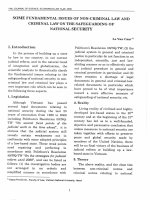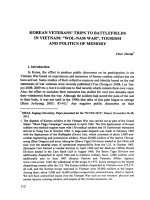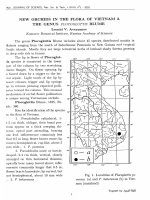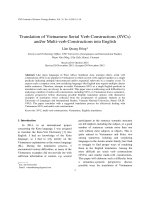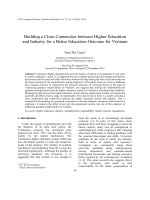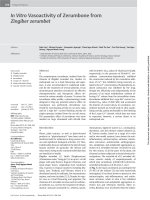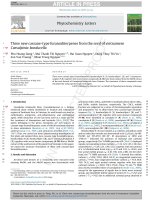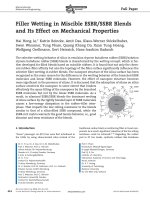DSpace at VNU: Curcuma pygmaea sp nov (Zingiberaceae) from Vietnam and notes on two related species C. parviflora and C. thorelii
Bạn đang xem bản rút gọn của tài liệu. Xem và tải ngay bản đầy đủ của tài liệu tại đây (1.78 MB, 9 trang )
Nordic Journal of Botany 31: 639–647, 2013
doi: 10.1111/j.1756-1051.2012.01749.x,
© 2013 The Authors. Nordic Journal of Botany © 2013 Nordic Society Oikos
Subject Editor: John Parnell. Accepted 30 October 2012
Curcuma pygmaea sp. nov. (Zingiberaceae) from Vietnam and
notes on two related species C. parviflora and C. thorelii.
Jana Leong-Škornicˇková, Otakar Šída and Trâ` n Hu˜’u Ða˘ng
J. Leong-Škorničková (), The Herbarium, Singapore Botanic Gardens, 1 Cluny Road, 259569 Singapore. – O. Šída,
Department of Botany, National Museum, Cirkusová 1740, Praha 9 – Horní Počernice 193 00, Czech Republic. – H. Đ. Trâ`n,
The Herbarium, Singapore Botanic Gardens, 1 Cluny Road, 259569 Singapore & University of Science, Vietnam National University, 227
Nguyen Van Cu, Q5, Ho Chi Minh City, Vietnam.
Curcuma pygmaea Škorničk. & Šída f. (Zingiberaceae), a new species from Vietnam, is described and illustrated. Notes on
its closest allies in Curcuma subgenus Hitcheniopsis, C. parviflora Wall. and C. thorelii Gagnep., are provided and a lectotype
of C. thorelii is designated.
Cambodia, Laos and Vietnam are a known diversity hotspot
for various plant families, although detailed data on Zingiberaceae are lacking as the last comprehensive account of this
region is over a century old (Gagnepain 1908). Our recent
work, consisting of extensive herbarium studies as well as field
exploration of this region, confirms the richness of gingers
we suspected and has resulted in descriptions of several new
and often stenoendemic species including two in Curcuma
(Leong-Škorničková et al. 2010; Leong-Škorničková & Lý
2010). All three currently accepted subgenera of Curcuma,
Curcuma, Ecomata and Hitcheniopsis, are well represented in
the Indochinese floristic region (sensu Takhtajan 1986) but
the identities of several species described in the past remain
unclear and numerous names have yet to be typified. As the
first author works towards a revision of Curcuma for the
‘Flora of Cambodia, Laos and Vietnam’ , the following
species has proved to be new and is described below. The
notes and type material of two closely related species,
C. parviflora Wall. and C. thorelii Gagnep., are discussed and
a lectotype of C. thorelii is designated.
Curcuma pygmaea Škornicˇk. & Šída f. sp.
nov. (Fig. 1)
Similar to Curcuma thorelii Gagnep., but smaller in habit,
up to 20 cm tall (vs. up to 50 cm tall), inflorescence with
6-13 green bracts decreasing in size towards the apex and no
coma (vs. 15-40 bracts and white spreading coma bracts).
Type: Vietnam. Dak Lak Province, Ea H’Leo Dist., Ea
H’Leo village, 308 m a.s.l.; 17 July 2010, Tran et al. 239
(holotype: SING (incl. spirit), isotypes: PR, VNM).
Rhizomatous herb to 20 cm tall. Rhizome sparsely
branched, main rhizome ovoid, 1.5–2 ϫ ca 1.5 cm, externally light brown, internally cream white, root tubers
ovate, 3 ϫ 1.5 cm, externally light brown, internally pure
white. Pseudostem 6–10 cm long, composed of 1–3
glabrous, leafless sheaths and 3–6 sheaths of leaves, innermost as long as the pseudostem, white-green with pinkish
tinge towards the base, outer ones gradually decreasing in
length, whitish green to white with pink tinge; ligule 2 mm
long, bilobed, hyaline, glabrous except for a few stipitate
hairs ca 0.2 mm long on the upper margin. Leafy shoot
with 2–5 leaves at flowering, ultimately to 6 leaves; petiole
3–7 cm long (except the first leaves which can be nearly
sessile), green, glabrous; lamina elliptic to narrowly ovate,
ca 5.5–15 ϫ 1.5–5 cm, glabrous, abaxially dark green with
a red patch along the midrib, adaxially lighter green, margin
hyaline, ca 0.1 mm wide, glabrous, apex acuminate, base
oblique. Inflorescence central. Peduncle ca 5–10 cm long,
hidden between the leaf sheaths. Spike 4–5 ϫ ca 2–3 cm,
coma absent. Bracts 6–13 per inflorescence, lower bracts
ca 2.2 ϫ 2.6 cm, completely green, glabrous, connate to one
another in lower 2/3, strongly reflexed at apex, all except the
uppermost 1–2 fertile (these are smaller, ca 1.5 ϫ 1.2 cm).
Cincinni with 6 flowers at the base of the inflorescence, the
number gradually decreasing upwards. Bracteoles minute,
one per flower, triangular, 5–7 ϫ 3–4 mm at base, hyaline,
translucent-white. Flowers ca 3 cm long, slightly exserted
from bracts. Calyx 6–7 mm long, 3-toothed, unilaterally
split for 2–3 mm from apex, white, glabrous. Floral tube
ca 1.8 cm long, narrowly cylindrical and funnel-shaped
towards the top, externally white, glabrous, internally white,
hairy in apical part; dorsal corolla lobe triangular-ovate,
ca 6 mm long and 4 mm at base, concave, glabrous, white,
639
Figure 1.Curcuma pygmaea Škorničk. & Šída f. sp. nov. (A) habit and detail of anther (inset), (B) flower (front view), (C) flower (side view),
(D) flower dissection and bract. Based on living collection Tran et al. 239; photos by Jana Leong-Škorničková.
640
C. pygmaea, and the information regarding the flower colour
available on the labels also does not match C. pygmaea. These
specimens may represent yet other new taxa, but further
examination of flowering material is needed.
apex slightly mucronate, with mucro ca 0.3 mm long, glabrous; lateral corolla lobes 5.5 ϫ 3 mm, triangular-ovate,
apex rounded, slightly concave, glabrous, white. Lateral staminodes ovate-rhomboid with asymmetric base, 6–7 ϫ 4–5
mm, white turning light violet towards the apex. Labellum
ca 8 ϫ 5 mm, spathulate, truncate at apex, bilobed, apex
split ca 3 mm, basal two thirds of the labellum violet with
white and dark violet patches in the centre, apex light violet.
Anther spurless, 2.75 ϫ 1.5 mm, light violet, with glandular
hairs on the sides of the connective, anther thecae 1.5 mm
long, cream white, dehiscing along the entire length; filament 1–1.5 mm long, white tinged violet, ca 2 mm broad
at base, ca 1 mm at the top, glabrous. Anther crest present,
1.5 ϫ ca 1 mm, violet, glabrous. Stigma white, unequally
funnel-shaped, ostiole glabrous. Epigynous glands absent.
Ovary ovoid, 2.5 ϫ 1.5 mm, trilocular, cream white, glabrous. Fruits and seeds not seen. Description based on herbarium, living and spirit material (Tran et al. 239).
Note: In cultivation, Curcuma pygmaea may become vegetatively more robust, with laminas to 25 ϫ 9 cm, and inflorescences with up to 16 bracts, but the sizes of the flower
parts do not change.
The specific epithet is derived from Greek pygmaios
( ϭ dwarfish) and reflects the small habit of this plant. So
far no vernacular names or uses have been recorded for this
species.
Phenology, habitat and distribution
Similar species
Curcuma pygmaea occurs in dipterocarp forests and flowers
from the centre of the leafy shoot around July. The leaf blades
are either plain green or with a red patch and this varies within
a single population. So far, this species is known only from
the type locality and no specimens have been encountered
during extensive revision of herbarium material at AAU, BK,
BKF, CAL, CMU, E, HN, HNIP, HNU, K, L, P, QBG, and
VNM. Among specimens of Curcuma parviflora from Thailand we have noticed several specimens (morphotypes 4 and
5) which also seem to lack a white coma and have fewer bracts
than C. parviflora, but they are of more slender habit than
Curcuma pygmaea falls in Curcuma subgenus Hitcheniopsis,
both according to Schumann’s (1904), and the most recent
infrageneric classification by Záveská et al. (2012). This subgenus is characterized by a central inflorescence with obtuse
bracts, adnate laterally and recurved at the tips, by the lack of
anther spurs and, as pointed out by Leong-Škorničková et al.
(2007), most importantly, by the lack of epigynous glands.
The closest species to C. pygmaea are C. parviflora Wall. and
C. thorelii Gagnep. (Fig. 2). Unlike C. pygmaea, both these
species have a clear distinction between green fertile bracts
and white coma bracts.
Chromosome count and genome size
Genome size of Curcuma pygmaea was measured using
PI-flow cytometry on Partec CyFlow ML following Otto‘s
simplified methodology (Otto 1990). The holoploid genome
size has been estimated as 2C ϭ 2.152 pg (measured against
internal standard Bellis perennis L., 2C ϭ 3.42 pg). The
chromosome number, 2n ϭ 24, was counted from root tips
prepared by the rapid squash method following the methodology described in Leong-Škorničková et al. 2007)
Etymology, vernacular names and uses
Figure 2.Curcuma parviflora and Curcuma thorelii. (A) Curcuma parviflora, Thailand, from living collections of Singapore Botanic Gardens Acc.
~u Đăng.
No. 20020340, photo by Jana Leong-Škorničková. (B) Curcuma thorelii, S. Vietnam, based on Tran et al. 178, photo by Trâ`n Hu
641
Curcuma parviflora is a species originally described from
forests on the banks of the river Irawaddy, at Prome and also
towards Ava, Burma (Wallich 1830). It is also widespread
in Thailand. Although it was also reported by Pha.m (2003)
from South Vietnam, no specimen was cited and so far we
have not encountered this species in Cambodia, Laos or
Vietnam, either in the field or in herbaria (Fig. 3). The main
characters of C. parviflora include a small habit, petiolate
leaves, green fertile bracts enclosing cincinni of white flowers
with a violet labellum and white coma bracts. An examination of herbarium material from the major herbaria listed
above revealed that there is a wide array of morphological
variability across the distribution area with at least five morphological types (Fig. 3). Various chromosome counts have
been also reported for this species, namely 2n ϭ 28, 30, 32,
34, 36 & 42 (Leong-Škorničková et al. 2007) suggesting that
C. parviflora as now recognized is a species with complex
reproductive biology perhaps consisting of more than one
taxon. It may also be found to hybridize with other sympatrically growing members of Curcuma subg. Hitcheniopsis – a
feature we have frequently observed in the field. Detailed
studies of living flowering material of the whole complex,
including cytology, and molecular analyses of these morphotypes are needed to resolve the complex.
Curcuma thorelii was described from Stung-treng, a
locality which at the time was part of Laos (Gagnepain
1907), but is now in Cambodia. Our herbarium study
and field records indicate that it occurs in Cambodia, Laos
and Vietnam and extends westwards to C and E Thailand.
The flowers of Curcuma thorelii and C. pygmaea are similarly coloured with the labellum and lateral staminodes
being violet, but plants of C. thorelii are much larger and
more robust than C. pygmaea, the inflorescence has welldeveloped white coma bracts and the lateral staminodes and
labellum are usually of a deeper colour.
Typification
Curcuma parviflora Wall. Pl. Asiat. Rar. 1: 47, t. 57.
1830. – Holotype (implicit): [icon] “Curcuma parviflora” in
Wallich, Pl. Asiat. Rar. t. 57. 1830.
Unlike several other ginger species described by Wallich,
where a specimen and a colour plate form the original material, the colour plate published with the original description
represents the only original element and is therefore treated
here as an implicit holotype.
Curcuma thorelli Gagnep. Bull. Soc. Bot. France 54: 406.
1907. – Lectotype (designated here): [Cambodia] Stungtreng, Thorel 2132, barcode P 032707 (P!; isolecto. barcode
P032708 and sheet with no barcode P!, sheet with no barcode CAL!) – excl. Thorel 2132 (P! barcode P 032706, K!
barcode K000255367).
Figure 3. Distribution of Curcuma parviflora, C. thorelii and C. pygmaea based on study of herbarium material.Curcuma parviflora - 5 major
morphotypes (typical form dark orange, morphotype 2 light orange, morphotype 3 yellow, morphotype 4 light yellow and morphotype 5
white); C. thorelii green; C. pygmaea in purple. Type localities of the three species are marked with stars.
642
The name C. thorelii is currently unambiguously applied
to a plant in Curcuma subgenus Hitcheniopsis with green
fertile bracts, white coma bracts and flowers with violet labellum and lateral staminodes. It was described by
Gagnepain (1907), who worked predominantly with herbarium material supplied to Paris by various collectors.
Gagnepain’s original description is based on Thorel’s collection No. 2132 from Stung-treng (currently located in
Cambodia) and specifically mentions the blue colour of the
flowers which is found only in members of subg. Hitcheniopsis. In most other features, it also matches the species
to which the name is currently applied fairly well. Curiously, the presence of two anther spurs and two epigynous
glands is also mentioned – both these characters are typical
of Curcuma subg. Curcuma but have never been recorded
in subg. Hitcheniopsis. Our examination of the original
material in Paris revealed that Thorel 2132 consists of four
sheets which have to be regarded as syntypes but which
are a mixed collection. Plants mounted on three sheets
(barcodes P 032707, P032708 and a sheet without barcode) are of a species in subgenus Hitcheniopsis to which
the name C. thorelii is currently applied (Fig 4.), while
the plant on the fourth sheet (barcode P 032706) belongs
to Curcuma aff. plicata, which is a member of subgenus
Curcuma. On the specimen, it may clearly be seen that
Gagnepain sampled and dissected the flower of Curcuma
aff. plicata, hence the misleading information about
epigynous glands and anther spurs (Fig. 5). We have located
two more duplicates of Thorel 2132: the duplicate at CAL
represents C. thorelii, while the plant on the duplicate at K
is Curcuma aff. plicata. In order to retain the name of the
species to which it is currently applied and for which there
is no other name available, we designate sheet P 032707
as the lectotype, sheets P032708, another at P without a
barcode, and the specimen at CAL as isolectotypes. We
propose here to exclude sheet P 032706 (P!) and sheet
K000255367 (K!) from the original material of C. thorelii.
Specimens examined:
Curcuma parviflora Wall., typical form
Myanmar: Prov. Bago: Pyay (Wallich 1830). Thailand:
Prov. Chiang Mai: 30 km S of Bo Luang along the Om
Koi trail, 3 Jul. 1968, K. Larsen, T. Santisuk & E. Warncke
2022 (AAU, BKF, E, P, C, L); N of Ban Om Koi, Bo
Luang Tableland, 17 Oct. 1979, T. Shimizu, H. Toyokuni,
H. Koyama, T. Yahara & T. Santisuk T-19033 (AAU,
BKF, C, L, P); Bo Luang to Om Koi, 10 Sep 1999,
P. Srisanga & C. Puff 1021 (QBG); ibidem, 12 Jun 1968,
C.F. van Beusekom & C. Phengklai 1176 (BKF, L); Om
Koi, 20 Jul 1987, C. Phengklai et al. 6260 (BKF); ibidem,
20 Jul 1987, C. Phengklai et al. 6302 (BKF); ibidem, 28
Jun 1978, C. Phengklai, M. Tamura, C. Niyomdham &
B. Sangkachand 4162 (BKF); ibidem, 28 Jun 1978,
C. Phengklai, M. Tamura, C. Niyomdham & B. Sangkachand
4171 (BKF); ibidem, 18 Oct 1979, T. Shimizu, H. Toyokuni,
H. Koyama, T. Yahara & T. Santisuk T-19354 (BKF); Sri
Sangwan waterfalls, Chiang Dao, 21 Jul 2003, C. Maknoi
(QBG); Doi Chiang Dao, 6 Jun. 1957, Khontchai 565 (C);
25 Sep. 1971, J.E. Vidal 5149 (P); Doi Suthep, 5 Jul. 1958,
T. Sorensen, K. Larsen & B. Hansen 3912 (C); ibidem; 9
Jul 1992, P. Palee 55 (E, P); ibidem, 8 Jul 1921, A.F.G.
Kerr 5641 (BK, C); ibidem, 3 Jul 1993, A. Phuakan 35
(BKF); ibidem, 11 Jul 1987, J.F. Maxwell 87-647 (BKF, L);
ibidem, 18 Sep 1967, T. Shimizu, H. Koyama & M. Hutoh
T-10467 (AAU); ibidem, 16 Jul 1988, M.N.Tamura
T-60072 (BKF); ibidem, 1 Aug 1922, Lung Ai s.n. (SN
256845) (BK); near Fang, 25 May 1958, K. Larsen &
B. Hansen 3598 (E, C); ibidem, 7 Jun 1973, R. Geesink,
D. Phanichapol & T. Santisuk (AAU, BKF, C, E, L, P) Dist.
Jawm Tong, Mae Soi valley, 29 Sep. 1991, J.F. Maxwell
91-782 (P, L, E); Mae Sa valley, 9 Jul 1974 J.N. Jackson
6134 (BKF); Mai Muang Mao Arboretum, 16 Oct 2001,
W. Sankamethawee 259 (L); San Pan See, 18 Jun 2002,
C. Glamwaewwong 211 (QBG); along highway between
Chon Thong and Ban Luang forest, 17 Sep 1967, K. Iwatsuki & N. Fukuoka T-10289 (AAU); en route from Mae
Klang waterfall to Sop Aep, 1 Oct 1971, G. Murata, K.
Iwatsuki, C. Pengklai & C. Charamphoi T-15519 (BKF).
Prov. Kanchanaburi: Hin Dat, 29 Jun. 1926, Put 44
(BK, C); between Huay Ban Kao and Kritee, 2 Jul. 1973,
R. Geesink & C. Phengklai 6070 (AAU, BKF, C, L); ibidem, 3 Jul 1973, Maxwell 73-70 (AAU, BK); Ni Kuhn
Streamlet, MKWRS, Tong Pha Phum, 12 Mar. 1961,
K. Bunchuai (AAU, BKF); ibidem, 28 May 1994, Th. W.
et al. 27 (BKF); Brangkasi, 19–22 Jun 1946, G. Den Hoed &
A. Kostermans 478 (BK, L, P); near Wangka, 23 May 1946,
S. Bloembergen 633 (BK, L, P); Ta Salao, 12 Jul 1940,
A.F.G. Kerr 14528 (BK, C, L); ibidem, 11 Jul 1930, A.
Marcan 2507 (C); Lum Sum, 30 Jul 1928, A. Marcan 2339
(C); Sangkha Buri, 12 Mar 1961, K. Bunchuai 73 (BKF); Si
Sawat, 17 Jul 1963, P.S. 2113 (BKF); ibidem, 12 Aug 1971,
CP, BS & BN 2913 (BKF); Sai Yok, 4 Dec 1961, K. Larsen
8495 (C); ibidem. 9 Jul 1945, A Kostermans 1040 (L);
Ban Kao, 10 Nov 1961, K. Larsen 8125 (C); Sriswasdi, 2
Jun 1962, Kasem 209 (BK); Thung Kang Yang, 6 Jul 1963,
K. Larsen 10539 (AAU); Doi Inthanon, along Mae Klang
river, 3 Aug 1988, M.N.Tamura T-60377 (BKF). Prov.
Lampang: Muang Bahn (Pan) district, Jae Sawn National
Park, near Jae Sawn Falls and Mae Nawn Stream, 24 Aug.
1995, J.F. Maxwell 95-596 (BKF, CMU, L); Distr. Muang
Pan, Jaesorn National Park, 28 Jun. 2002, N. Koonkhunthod, N. Supantee & N. Thesana 199 (BKF). Thoen Dt.,
50 km south of Thoen, 13 Oct. 1979, T. Shimizu, H.
Toyokuni, H. Koyama, T. Yahara & T. Santisuk T-13538
(BKF); Doi Pang La, Huay Tak, 25 Sep 1967, T. Shimizu,
H. Koyama & A. Nalampoon T-10776 (AAU, BKF); Hui
Tak, 9 August 1964, C. Hambananda 225 (BKF). Prov.
Mae Hong Son: 19–24 km east of Mae Sariang towards the
Salawin River, 17 Jul. 1998, W.J. Kress, M. Bordelon &
M. Collins 98-6216 (AAU); Along the road between Mae
Sariang and Mae La Noi, 18 Sep 1967, K. Iwatsuki & N
Fukuoka T-10389; ibidem, 28 Jul. 2007, A. Keratikorkol
352 (QBG); Maesarieng, 8 July 1966, Prayad 345 (BK).
Prov. Nakhon Sawan: Hua Wai, Taklee, 10 Jul. 2007, C.
Maknoi 1634 (QBG). Prov. Phetchaburi: Amphoe Kaeng
Krachan: Kaeng Krachan National Park, on road to Thor
Thip waterfall, 8 Aug. 2002, D. Middleton, S. Suddee, S.J.
Davies & C. Hemrat 856 (AAU); ibidem, limestone area in
the central part of the Park, Khao Pa Karang, 3 Aug 1995,
643
Figure 4. Proposed lectotype of Curcuma thorelii, Thorel 2132, P 032707. (A) entire sheet, (B-C) details of inflorescences, (D) detail of
label. Photo by Jana Leong-Škorničková.
K. Larsen, S.S. Larsen, C. Tange, R. Moran & P. Puudjaa
45379 (AAU). Prov. Prachuap Khiri Khan: Amphoe Pran
Buri, Kui Buri National Park, trail from park headquarters, 20 Aug. 2002, D.J. Middleton, S. Suddee & C. Hemrat 1242 (BKF, CMU, E). Prov. Ratchaburi: Ban Saphan,
13 Aug. 1966, K. Larsen, T. Smitinand & E. Warncke
1547 (BKF); South of Prachuap, 13 Aug 1966, K. Larsen, T. Smitinand & E. Warncke 1557 (BKF); Amper
Suan Pueng, 28 May 1987, Y. Paisooksantivatana & P.
Sangkhachand 2008-87. Prov. Tak: Khao Pha wo, ca. 70
644
km west of Tak, 23 Jul. 1973, G. Murata, N. Fukoka &
C. Phengklai T-16873 (AAU, BKF, C, L); km 27 Um
Pang-Palata, Um Pang, 1 Jun 2006, S. Watthana 1971
(QBG); Lan Sang National Park, 20 Apr 1985, C. Niyomdham 900 (AAU, BKF, C); ibidem, 1 Sep 1967, M.
Tagawa, K. Iwatsuki, H. Koyama & A. Chintayungkun
T-8662 (AAU); ibidem, 1 Sep 1967, M. Tagawa, K. Iwatsuki, H. Koyama & A. Chintayungkun T-8663 (AAU);
Amper Mae Sod, 8 Aug 1989, Y. Paisooksantivatana
2394-89 (BK).
Figure 5. A sheet of Curcuma aff. plicata proposed to be excluded from the original material of Curcuma thorelii, Thorel 2132, P 032706.
(A) entire sheet, (B) detail of inflorescence, (C) drawing of the dissected flower attached to the sheet (D) dissection of the flower (E) detail
of label. Photo by Jana Leong-Škorničková.
645
Curcuma parviflora Wall., morphotype 2
Curcuma parviflora Wall., morphotype 5
Thailand: Prov. Chaiyaphum: Ban Nam Phrom, 24 May
1974, R. Geesink, T. Hattink & C. Phengklai 6904 (BKF, L).
Thung Lui Lai, 27 Jul. 1999, C. Ngamriabsakul 59 (BKF, E).
NW of Phu Khieo, 6–7. Aug 1972, K. Larsen, S. S. Larsen,
I. Nielsen & T. Santisuk 31551 (AAU). Phu Khieo E of
Chaiyaphum, 3. Aug 1972, K. Larsen, S. S. Larsen, I. Nielsen
& T. Santisuk 31551 (AAU). Kaengkhro, 18 May 1996, sine
coll., SN113583/BKF118377 (BKF). Prov. Chantaburi:
Pong Nam Ron, Hindat, 30 Aug. 1956, T. Smitinand 3456
(AAU, BKF, C). Foot of Khao Soi Dao, 10 Nov. 1969, C.F.
van Beusekom & T. Smitinand 2097 (AAU, BKF, L, P),
ibidem, 6 Jun 1963, K. Larsen 9802 (AAU). Khao Sip-ha
Chan NP, Khun Song, Kaeng Hang maeo, 26 Aug 2004,
K. Kertsawang 390 (QBG). Prov. Nakhon Nayok: Kow Yai
National Park, Hayosuwat Falls, 31 Aug. 1974, J.F. Maxwell
74-865 (AAU, BK, L). Prov. Nakhon Ratchasima: Kao Yai
National Park, 19 Jul 1973, G. Murata, N. Fukuoka & C.
Phengklai T-16321 (AAU, BKF, C, L); ibidem, 19 Jul 1973,
G. Murata, N. Fukuoka & C. Phengklai T-16372 (BKF);
ibidem, 17 Dec 1962, C. Phengklai 567 (c). Khao Ko pang
mar, Paktongchai, 17 Jul 2008, P. Weesumritt 238 (QBG).
Prov. Prachin Buri: Khao Yai National Park, Khao Khieo,
Heo Suwat Falls, 8 Jul. 1967, K. Larsen, T. Smitinand &
E. Warncke 94 (AAU, BKF, P).
Thailand: Prov. Saraburi: Muak Lek, hill W of Forest
Station, limestone hill, 2 Oct. 1963, T. Smitinand &
H. Sleumer 1308 (BKF, L), ibidem, 31 Aug 1924, A. F. G.
Kerr 9087 (BK, C, L). Muang Dt., Sahm Lahn forest, 12 Jul
1975, J.F. Maxwell 75-683 (AAU, BK, L).
Curcuma parviflora Wall., morphotype 3
Thailand: Prov. Kamphaeng Phet: Mae Wong National Park
– Kamphaeng Phet side, near HQ, 7 Jul. 1999, C. Ngambriasakul 32 (BKF, E). Klong Laan Waterfall, Nam Tok Klong
Laan, Klong Laan, 25 Oct. 2001, S. Watthana 1509 (QBG).
Klong Lan National Park, track to east of Waterfall, 21 Aug.
1995, Parnell, Pendry, Jebb & Pooma 95-319 (AAU). Klong
Lan, 1 km from Parks HQ. 27 Jul 1997, M. Van den Bult 13
(BKF). Wang Chao Waterfalls, 4 Oct. 2003, C. Maknoi 522
(QBG). Prov. Loei: Phu Krading, 11 Sep. 1963, H. Sleumer
4753 (L), ibidem, 3 Sep 1967, T. Schimizu, M. Hutoh &
D. Chaiglom 8779 (AAU, BKF), ibidem, 5 Sep 1969, P.
Sanhkhachand 2072 (BK), ibidem, 15 Oct 1967, Preyad
1035 (BK). Wang Sa Pung, 21 Apr. 1948, D. Nakkan 215
(BKF). Prov. Lop Buri: Huai Hin, Chaibadan, 11 Jul. 2007,
C. Maknoi 1642 (QBG). Prov. Petchabun: Ban Nam Ron,
Mueang, 19 Jul 2002, C. Maknoi 299 (QBG). Haeo Sai
Waterfall, Namnao NP, 7 Jul. 2002, C. Maknoi 268 (QBG).
Prov. Phitsanulok: Kaeng Sopa Waterfalls, Nakornthai, 24
Aug. 2003, C. Maknoi 493 (BKF, QBG). Thung Salaeng
Luang National Park, about 20 km E of Phitsanulok, 21 Oct.
1984, G. Murata, C. Phengklai, S. Mitsuta, T. Yahara,
H. Nagamasu & N. Nantasan T-38217 (BKF). Thung
Salaeng Luang National Park, Tan Ta Wang village, 22
Oct. 1984, G. Murata, C. Phengklai, S. Mitsuta, T. Yahara,
H. Nagamasu & N. Nantasan T-38217 (BKF).
Curcuma parviflora Wall., morphotype 4
Thailand: Prov. Nong Khai: Phu Wua Wildlife sanctuary,
9 Aug. 2004, I.C. Nielsen, C. Niyomdham, T. Jonganurak,
C. Hemrath & J. Rithipheth 1603 (AAU). Ban Tong,
Seka district, Jet Si Waterfalls, 20 May 2004, R. Pooma,
K. Phattarahirankanok, S. Sirimongkol & M. Poopath
4109 (BKF).
646
Curcuma thorelii Gagnep.
Thailand: Prov. Loei: Phu Rua Dt., Phu Rua N. P., 12 Jun.
2004, T. Wongprasert et al. 046-65 (BKF). Prov. Kalasin:
Kuchinarai, Galasintu, 9 Aug 1963, Pradit 355 (BK). Prov.
Lop Buri: Wat Tham Petnaka, Lam Sonthi, 21 Aug. 2003,
C. Maknoi 485 (AAU, QBG). Prov. Nong Khai: Dong
Srichompoo, 28 Jun 1963, Adisai 577 (BK). Prov. Phitsanulok: Chattrakan Dt., 19 Jun. 2006, A.D. Poulsen &
P. Suksathan 2393 (QBG). Tung Salaeng Luang, 21 Jul.
1966, K. Larsen, T. Smitinand & E. Warncke 656 (AAU,
BKF, L, P). Prov. Sakhon Nakhon: Phu Paan National Park,
6 Aug. 2004, I.C. Nielsen, T. Jonganurak, N. Hemrath &
J. Rithipheth 1539 (AAU, BKF); ibidem, Aug 1987,
P Yuktathat 142 (E); ibidem, 31 Jul 1999, M.F. Newman
945 (BKF, E). Prov. Ubon Ratchathani: Phibulmangsahawn Dt., 9 Jul. 2004, T. Wongprasert 047-7 (BKF). Roadside KM 38-37, Ban Sanam Chai. Phibun Mungsahan, 21
Aug. 2001, R. Pooma, W.J.J.O. de Wilde, B.E.E. Duyfjes,
V. Chamchumroon & K. Phattarahirankanok 2192 (BKF).
Laos: Prov. Champassak: Phou Chieng, 10 Sep. 1952,
J.E. Vidal 1898 (P). Cambodia: Prov. Stung Treng: Stung
Treng, 1866-1868, C. Thorel 2132 (P). Prov. Pursath:
Klong, 18 Nov. 1938, M. Muller 517 (P). Vietnam: Prov.
Binh Thuan: La Gi, 3 Jul. 1925, M. Evrard 2322 (AAU, P).
Prov. Tây Ninh: Tay Ninh, 12 Jul 1939, R Muller 1523 (P).
Prov. Thu` a Thiên-Huê´: Huê´, Sep. 1877, Harmand 4891
(P). Prov. Dak Lak: Ea H’Leo Dist., Ea H’Leo village, 17
Jul. 2010, Tran et al. 238 (PR, SING).
Acknowledgements – We thank the curators of AAU, BK, BKF,
CAL, CMU, E, HN, HNIP, HNU, K, L, P, QBG, SING and
VNM herbaria for letting us examine and photograph the specimens in their care, the Asian Zingiberaceae Information Centre
at Singapore Botanic Gardens and the Zingiberaceae Resource
Centre at the Royal Botanic Garden Edinburgh (Ͻhttp://elmer.
rbge.org.uk/ZRC/Ͼ) for providing protologues and related references. We thank Dr. Axel D. Poulsen and Dr. Mark Newman
for useful comments on the manuscript. Our research was
funded by National Parks Board, Singapore, the Czech Science
Foundation, GAČR (grant no. 521/09/0202 and P506/10/0623)
and Ministry of Culture of the Czech Republic (DKRVO
2013/10 National Museum, Prague).
References
Gagnepain, F. 1907. Zingibéracées, Marantacées et Musacées nouvelles de l’herbier du Museum. Bull. Soc. Bot. France 54:
403–413.
Gagnepain, F. 1908. Zingibéracées. In: Lecomte, H. (ed.),
Flore Générale de l’Indo-Chine. Vol. 6. Masson and Co,
pp. 25–121.
Leong-Škorničková, J., Šída, O., Jarolímová, V., Sabu, M., Fér, T.,
Trávníček, P. and Suda, J. 2007. Chromosome numbers
and genome size variation in Indian species of Curcuma
(Zingiberaceae). Ann. Bot. 100: 505–526.
Leong-Škorničková, J., Trâ`n, H.D. and Newman, M.F. 2010.
Curcuma vitellina (Zingiberaceae), a new species from
Vietnam. Gard Bull Singapore 62(1): 111–117.
Leong-Škorničková, J. and Lý, N.S. 2010. Curcuma pambrosima
sp. nov. (Zingiberaceae) from central Vietnam. Nord. J. Bot.
28: 652–655.
Otto, F. 1990. DAPI staining of fixed cells for high-resolution flow
cytometry of nuclear DNA. – In: Crissman H.A., Darzynkiewicz, Z. (eds.), Methods in cell biology, Vol 33. New York:
Academic Press, pp. 105–110.
Pha.m, H.H. 2003. Cây cỏ Viê. t Nam, An illustrated Flora of
Vietnam. Vol. 3: 432–461. Youth Publication, Hochiminh City.
Schumann, K. 1904. Zingiberaceae. – In: Engler, A. (ed.), Das
Pflanzenreich IV, Vol. 46. Leipzig, pp. 1–458.
Takhtajan, A. 1986. Floristic regions of the World, (trans.
T.J. Crovello & A. Cronquist). Berkeley: University of
California Press.
Wallich, N. 1830. Plantae Asiaticae Rariores, vol 1, part 3.
– Treuttel and Würtz: Treuttel Junr. and Richter. London,
England.
Záveská, E., Fér, T., Šída, O., Krak, K., Marhold, K. and LeongŠkorničková, J. 2012. Phylogeny of Curcuma (Zingiberaceae)
based on plastid and nuclear sequences: Proposal of the new
subgenus Ecomata. Taxon 61 (4): 747–763.
647
